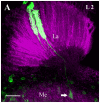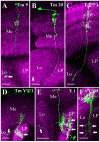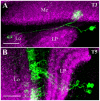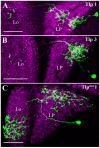Candidate glutamatergic neurons in the visual system of Drosophila
- PMID: 21573163
- PMCID: PMC3088675
- DOI: 10.1371/journal.pone.0019472
Candidate glutamatergic neurons in the visual system of Drosophila
Abstract
The visual system of Drosophila contains approximately 60,000 neurons that are organized in parallel, retinotopically arranged columns. A large number of these neurons have been characterized in great anatomical detail. However, studies providing direct evidence for synaptic signaling and the neurotransmitter used by individual neurons are relatively sparse. Here we present a first layout of neurons in the Drosophila visual system that likely release glutamate as their major neurotransmitter. We identified 33 different types of neurons of the lamina, medulla, lobula and lobula plate. Based on the previous Golgi-staining analysis, the identified neurons are further classified into 16 major subgroups representing lamina monopolar (L), transmedullary (Tm), transmedullary Y (TmY), Y, medulla intrinsic (Mi, Mt, Pm, Dm, Mi Am), bushy T (T), translobula plate (Tlp), lobula intrinsic (Lcn, Lt, Li), lobula plate tangential (LPTCs) and lobula plate intrinsic (LPi) cell types. In addition, we found 11 cell types that were not described by the previous Golgi analysis. This classification of candidate glutamatergic neurons fosters the future neurogenetic dissection of information processing in circuits of the fly visual system.
Conflict of interest statement
Figures









References
-
- Fischbach KF, Dittrich APM. The optic lobe of Drosophila melanogaster. I. A Golgi analysis of wild-type structure. Cell Tissue Res. 1989;258:441–475.
-
- Strausfeld NJ. Atlas of an Insect Brain. 1976a. Springer: Berlin.
-
- Strausfeld NJ. Zettler F, Weiler R, editors. Mosaic organization, layers and visual pathways in the insect brain. Neural Principles of Vision. 1976b. pp. 245–279. Springer: Berlin.
-
- Strausfeld NJ. Ali M A, editor. Functional anatomy of the blowfly visual system. Photoreception and Vision in Invertebrates, ed. 1984. pp. 483–522. New York: Plenum Press.
-
- Joesch M, Schnell B, Raghu SV, Reiff DF, Borst A. ON and OFF pathways in Drosophila motion vision. Nature. 2010;468:300–304. - PubMed
Publication types
MeSH terms
Substances
LinkOut - more resources
Full Text Sources
Molecular Biology Databases
Miscellaneous

